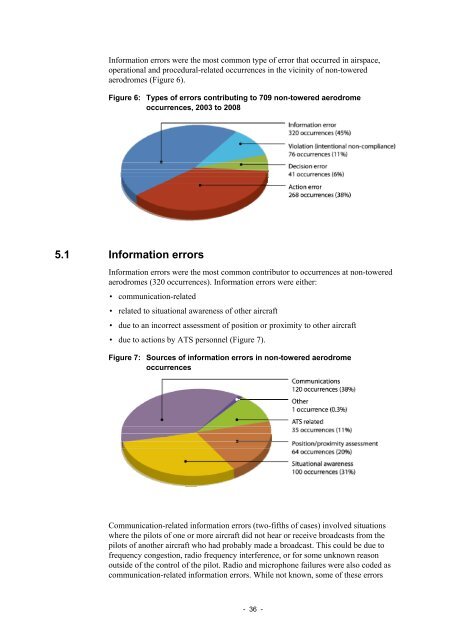Safety in the vicinity of non-towered aerodromes - Australian ...
Safety in the vicinity of non-towered aerodromes - Australian ...
Safety in the vicinity of non-towered aerodromes - Australian ...
Create successful ePaper yourself
Turn your PDF publications into a flip-book with our unique Google optimized e-Paper software.
Information errors were <strong>the</strong> most common type <strong>of</strong> error that occurred <strong>in</strong> airspace,<br />
operational and procedural-related occurrences <strong>in</strong> <strong>the</strong> vic<strong>in</strong>ity <strong>of</strong> <strong>non</strong>-<strong>towered</strong><br />
<strong>aerodromes</strong> (Figure 6).<br />
Figure 6: Types <strong>of</strong> errors contribut<strong>in</strong>g to 709 <strong>non</strong>-<strong>towered</strong> aerodrome<br />
occurrences, 2003 to 2008<br />
5.1 Information errors<br />
Information errors were <strong>the</strong> most common contributor to occurrences at <strong>non</strong>-<strong>towered</strong><br />
<strong>aerodromes</strong> (320 occurrences). Information errors were ei<strong>the</strong>r:<br />
• communication-related<br />
• related to situational awareness <strong>of</strong> o<strong>the</strong>r aircraft<br />
• due to an <strong>in</strong>correct assessment <strong>of</strong> position or proximity to o<strong>the</strong>r aircraft<br />
• due to actions by ATS personnel (Figure 7).<br />
Figure 7: Sources <strong>of</strong> <strong>in</strong>formation errors <strong>in</strong> <strong>non</strong>-<strong>towered</strong> aerodrome<br />
occurrences<br />
Communication-related <strong>in</strong>formation errors (two-fifths <strong>of</strong> cases) <strong>in</strong>volved situations<br />
where <strong>the</strong> pilots <strong>of</strong> one or more aircraft did not hear or receive broadcasts from <strong>the</strong><br />
pilots <strong>of</strong> ano<strong>the</strong>r aircraft who had probably made a broadcast. This could be due to<br />
frequency congestion, radio frequency <strong>in</strong>terference, or for some unknown reason<br />
outside <strong>of</strong> <strong>the</strong> control <strong>of</strong> <strong>the</strong> pilot. Radio and microphone failures were also coded as<br />
communication-related <strong>in</strong>formation errors. While not known, some <strong>of</strong> <strong>the</strong>se errors<br />
- 36 -
















